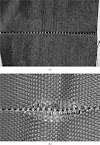Desizing
Objective:
To remove the size applied to the grey fabric as a part of
weaving process, so that the fabric becomes free from the added matter and it
can be effectively processed further.
·
Chemically Starch is a glucose polymer in which
glucopyranose units are bonded by alpha-linkages in which Amylose is linear
chain and amylopectin branch chain are present.
·
Both of these are insoluble in water but can be
solubilized by the hydrolysis of long-chain compounds into shorter one.
·
This under suitable conditions starch is
hydrolysed and finally it is converted into glucose which is a soluble form.
·
Indie sizing hydrolysis is controlled or carried
out up to Dextrin (C6H12O5)l stage only.
·
The sizing is a chemical process and it can be
controlled e.g. if concentration of chemical in desizing bath is higher, the
process can be completed in short duration and vice versa.
·
Desizing can be carried out in continuous or
batch wise manner.
Methods / classification of Desizing
1.
Hydrolytic method
a.
Rot steeping
b.
Acid desizing
c.
Enzymatic desizing
2.
Oxidative method
a.
Chlorine
b.
Chlorite
c.
Bromite
3.
Novel method
a.
Solvent desizing
b.
Low temperature plasma temperature
c.
Desizing 2000
Below are Hydrolytic method process
1. Rot steeping
·
This is oldest and cheapest method.
·
No special chemicals are used.
·
The grey cotton fabric is first stepped or
immersed in water at 40°C and then passed through padding mangle to give 100%
expression.
·
Then it is piled in a tank and allowed to stand
for 24 hours.
·
During the storage the microorganisms naturally
present in water secret starch liquefying enzymes which hydrolysed the starch
present in the size.
·
Then the fabric is washed to remove the
hydrolysed starch.
·
The actual process is fermentation and
precaution should be taken that fermentation is not too active otherwise
cellulose itself may be attack and strength loss may occur.
Advantages:
· - Most economical and easy process.
· - No specific chemicals and machinery is required.
Disadvantages:
· - Low efficiency
· - Due to longer time production is less
· - Degradation of cellulose and due to uncontrolled
fermentation
· - It requires a large floor space.
2. Acid desizing
·
In this method cotton fabric is treated with
dilute sulphuric acid (H2SO4) or hydrochloric acid (HCL)
·
The acid hydrolyses of starch present in the
size fabric.
·
It attacks the polymer chain of starch and does
lower down the molecular weight of starch which is converted into soluble form.
·
The concentration is used is 5 to 10 gpl or 0.5
to 1% at temperature of about 40°C.
·
The treatment is continued for 3 to 4 hours. The
acid immersed fabric is squeezed evenly and is batched and weight on a roller.
·
The weight roll is covered with polythene film
and kept aside in a storage room with the role in rotating condition so that it
remains uniformly weight during the sizing action for required period.
·
Then the fabric is washed in open width soaper
till it gets free from acid and the hydrolysed product.
·
Precaution must be taken that acid treated
fabric roll is covered properly and kept rotating during storage time.
·
If any part of the fabric dries up before
washing, cellulose will be formed and tendering of fabric may occur.
Advantages:
· -The process is economical
· - As compared to rot stripping it requires less
time, thus production is more.
· - It does not require specific condition of
temperature and pH. It can be done at room temperature and thus the energy
consumption is less.
Disadvantages:
· - There are chances of tendering of cellulose.
3. Enzymatic desizing
·
Enzymes are organic biocatalyst. This are
highest specific both in a reaction catalyst and their choice of reactance. i.e.
substrate
·
Deciding enzymes like amylase liquefy the
starches in the fabric and these are classified on the basis of source they are
obtained.
·
Desizing enzymes –
Animal sources –
-
Veveral
-
Degomma
-
Pancreatic
-
Novofermosal
Vegetable sources –
-
Malt Extract (e.g. Diastafore, Diastace,
Maltostace)
-
Bacterial Extract (e.g. Raddase, Arey, Take)
·
The feature of enzyme deciding process is the
specific nature of the action of the enzymes which are active under certain
condition of concentration, pH and temperature.
·
The optimum concentration, pH and temperature at
which different enzymes are effective as desizing agent are given as follows:
|
Enzymes |
Concentration (gpl) |
Temperature (°C) |
|
Malt Extracts |
3-20 |
50-60 |
|
Pancreatic |
1-5 |
50-60 |
|
Bacterial |
0.5-1 |
60-70 |












0 Comments
If you have any doubts, please don't hesitate to ask